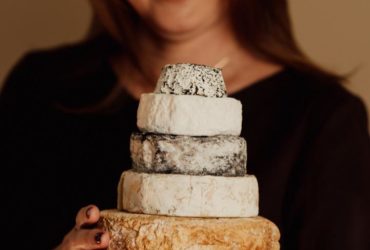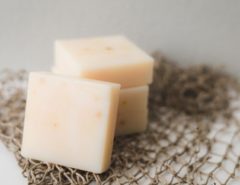By Allison Howell
One night mid-pandemic, I fell victim to the late-night doom scroll on Twitter. Somewhere along the latest virus news, work from home memes, and updates on baking projects, a mystery caught my eye. While I can’t recall the exact tweet I saw, this tweet from Julie Van Rosendaal does a pretty good job of summing it up. I read through a few replies and links before chuckling to myself, putting my phone down, and attempting to sleep. I didn’t think about it again for a few months until I stumbled upon a NY Times article with a curiously familiar title: “Canadians Try to Solve the Enigma of Hard Butter.” Now this had my attention. Like many others, the pandemic sparked an interest in baking for me, and I latched on to it. Baking homemade cinnamon rolls, banana breads, sugar cookies, and even one somewhat successful attempt at macarons. But as food science student, butter had always fascinated me. The sheer number of butter varieties available in the grocery aisle can sometimes be overwhelming (I tend to stick to classic salted stick butter or Earth Balance sticks for dairy-free baking). I had made many attempts to soften butter quickly when I forgot about the batch of cookies I had planned to make, or the small ceramic butter dish had been found empty after cutting off a slice of banana bread. Check out this Kitchn article for some of the best butter-softening options. (Spoiler alert: I like wrapping cold butter in plastic wrap and pounding with a rolling pin – it’s both fun and effective!)
But back to Butter-gate…
What started out as a couple of tweets about stubborn butter refusing to soften had garnered the attention of scientists and national reporters, alike. Everyone wanted to know what happened to Canada’s butter. The scandal even caught the attention of Dr. Sylvain Charlebois of the Agri-food Analytics Lab at Dalhousie University, who published an opinion piece on the matter in late February. Dr. Charlebois offered an explanation for the hard butter conundrum: increased demand for butter and milk products led to supplementing cow feed with Palm oil1. Palm oil has been shown to increase milk yields, milk fat percentage, and milk fat yield when fed to Holstein cows.2
But the threat of palm oil is not new to the dairy industry. Because it is cheap, palm oil has been used as an adulterant in butter, but the use of palm oil in cow feed is less well studied. New technologies are being developed to assist in identifying palm oil adulteration in butter. A 2015 article titled “Rapid quantitative determination of butter adulteration with palm oil using the DSC technique” presented a new method for identifying adulteration in butter.3 But an interest in identifying palm oil in butter begs an important question: was the palm oil used as an adulterant in the production of butter or fed to the cow prior to milk production? It’s not uncommon for an additive in animal feed to have an effect farther down the line (see mycotoxins).
But in Dr. Charlebois’ article she shared an important quote “A Buttergate is not what the industry needs, or what Canadians deserve. Let us hope the dairy industry can clean itself up before its moral contract with Canadians is permanently damaged.”1 This quote is powerful in its simplicity that transparency in food production is imperative, and customer’s perception is important to being successful in the food industry. While, the use of palm oil in cow feed is not illegal, customers noticed a change in the quality of a beloved product and many felt duped as if the dairy industry was trying to pull one over on them4. Whether or not palm oil is the reason many Canadian’s are now finding themselves between a rock and some hard butter, food scientists and individuals across the food industry alike can learn an important lesson from what started with a single tweet: transparency in all aspects of our food system are important for providing quality products to customer’s and maintaining the ever-important brand image.
References
(1) Charlebois, D. S. Opinion: Buttergate and the “hard” truth about Canadian butter https://montreal.ctvnews.ca/opinion-buttergate-and-the-hard-truth-about-canadian-butter-1.5320211 (accessed Apr 7, 2021).
(2) Mosley, S. A.; Mosley, E. E.; Hatch, B.; Szasz, J. I.; Corato, A.; Zacharias, N.; Howes, D.; McGuire, M. A. Effect of Varying Levels of Fatty Acids from Palm Oil on Feed Intake and Milk Production in Holstein Cows. J. Dairy Sci. 2007, 90 (2), 987–993. https://doi.org/10.3168/jds.S0022-0302(07)71583-7.
(3) Tomaszewska-Gras, J. Rapid Quantitative Determination of Butter Adulteration with Palm Oil Using the DSC Technique. Food Control 2016, 60, 629–635. https://doi.org/10.1016/j.foodcont.2015.09.001.
(4) Telegram, T. EDITORIAL: Beyond butter — palm oil is in almost everything | The Telegram http://www.thetelegram.com/opinion/local-perspectives/editorial-beyond-butter-palm-oil-is-in-almost-everything-558661/ (accessed Apr 7, 2021).

Allison Howell | Linkedin
Guest SMF Blog Writer
Allison Howell is a PhD student in Food Science and Technology at The Ohio State University. She earned her Bachelor’s degree in Microbiology and minors in Pharmaceutical Science and Health, Environment, Risk, and Science Communication also from The Ohio State University. Her research focuses on understanding how consumers make decisions about food safety, and how government and non-profit organizations can create policies for balancing risks across food safety, food security, and food waste. Allison loves to bake and is always researching and trying out new swaps to make recipes more allergy and dietary restriction-friendly.






Leave a Reply